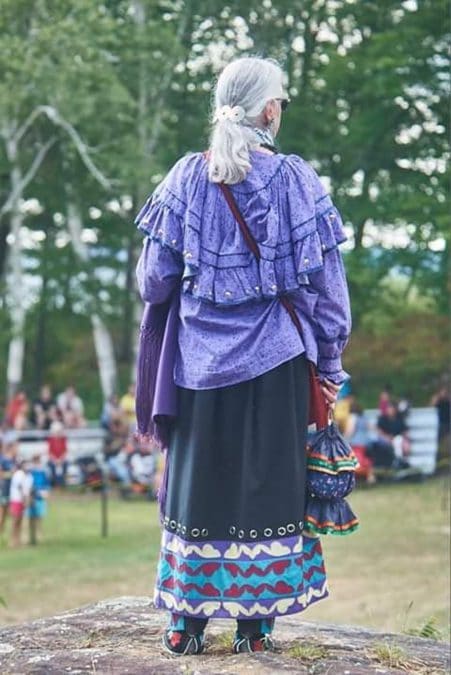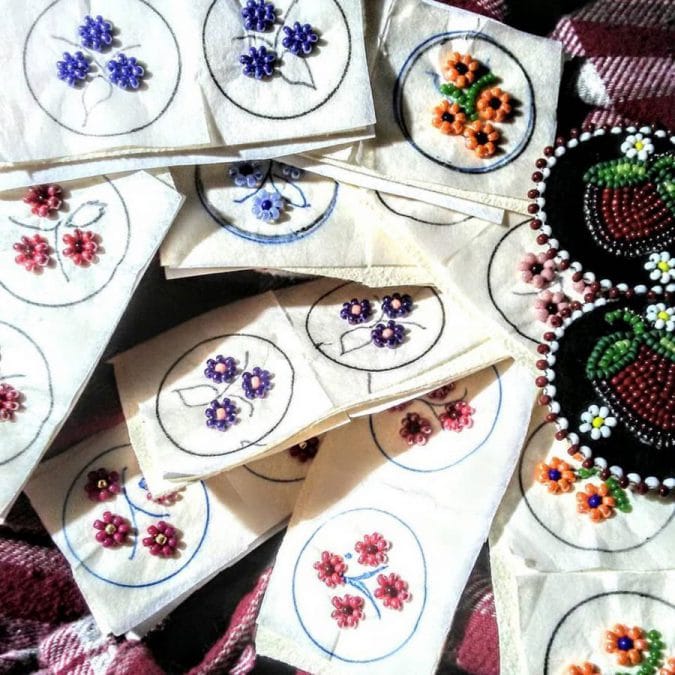Potawatomi artisan Peggy Hancock Kinder’s artistic outlets span all forms of needlework from hand-tied shawls, hand-stitched ribbon work, aprons and other regalia to beaded applique earrings and beaded fan handles. In her youth, Kinder honed her skills by spending quality time studying under her aunt, mother and other relatives. Today, the Bourassa descendant continues the family tradition.
“Some people can read books, and the world could fall down around them and they don’t know it; that’s how I am when I do beadwork,” she said.

assistant and her love for crafting to create jewelry,
regalia and more. (Photo provided)
Inspiration
For her creations, Kinder utilizes Nishnabé imagery and themes from traditional garments held in museum archives as well as contemporary, natural elements.
“I went up to the archives in Washington (D.C.). … It was incredible, just being able to look and touch things that were made by ancestors,” she said. “I just couldn’t stop thinking about who the person was who made this and all the knowledge that this piece has that we don’t know.”
She explained that beaded designs often included traditional medicinal recipes and information, and Kinder takes her role seriously in keeping Potawatomi needlework traditions alive for generations to come.
“It would be great to know all about the reasons certain florals were chosen … what their purposes were to the beader,” she said. “I ask people up north what I can, and they can give me the information they can. It’s all very interesting; you never stop learning — never ever.”
Floral and woodland-inspired imagery are mainstays in her work, continuing the Potawatomi tradition of incorporating nature’s beauty into art.
“I love to do berries, like chokecherries and blueberries and juniper, but the strawberry and strawberry blossom are probably my favorites,” Kinder said.
Foraging connections
Kinder appreciates those who have taken the time to impart their knowledge, helping improve her craft.
“It means so much,” she said. “I feel that I am an extension of my aunt’s work, and especially when I do hand-stitched ribbon work.
“It connects me to my aunt and my grandmother. Not many people do it anymore.”
Throughout the years, Kinder has noticed fewer individuals showing interest in hand-stitched ribbon work. This further inspires her efforts.
She utilizes every chance to share her skills with others to reciprocate the gift of knowledge.

“It means a lot to teach these classes because the women that attend, and sometimes men, are so amazed by the process, and it’s a process that our relatives did,” she said. “It just feels so good to show them and to see somebody get excited about it.
“Hand-stitched ribbon work is a dying art, and anything I can do to prevent that from happening means the world to me.”
For many, ribbon work can appear difficult and intricate, but Kinder enjoys uncovering its simplicity.
“I love the process — the creative process, and the colors. It’s really very cool,” she said.
Kinder encourages beginners to learn the “old-style” first.
“I always tell (my students), ‘I’m going to teach you this way first because this is how it was done,’ before we move on to the sewing machine and Wonder-Under. I want them to have the experience of connecting with our ancestors,” she said.
Personal touches
Kinder usually does not fill in the background of her applique beadwork. Her approach utilizes the negative space fabric, leather or other mediums to make each design shine. For most pieces, she uses black ultra-suede or black velveteen as the base.
“And that’s a very woodland thing to do, although I know that filling in the background with white is also very Potawatomi,” she explained.
Though versed in several beading methods, Kinder prefers single-needle applique and peyote stitch.
“I feel like I can hold onto the tension better and kind of manipulate things a little bit more with a single needle than double,” she said.
She keeps ideas new and fresh by evolving her designs to meet customer requests.
“I would say I go in phases,” Kinder said. “There was a period of time where I worked on ribbonwork all the time: skirts and men’s dance aprons and trailers. But now I love doing beadwork, and I am in that phase right now. I am blessed that I get a lot of orders for my beadwork.”
Potawatomi Gifts inside the Citizen Potawatomi Nation’s Cultural Heritage Center has a limited number of Kinder’s beaded Nishnabé-inspired earrings in stock. Shop in store or online today at potawatomigifts.com.
